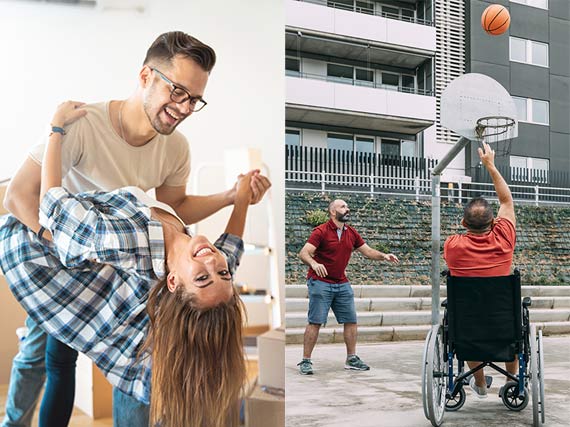Healthy eating is only one part of the equation. If anyone tries to tell you you can get healthy without increasing your physical activity, walk away. Briskly.
Sitting Statistics
Research shows that sitting for more than 10 hours per day increases your risk of cardiovascular disease, Type 2 diabetes, and depression. A sedentary lifestyle is even linked to certain types of cancer, particularly breast cancer, colorectal cancer, and endometrial cancer.Exercise is beneficial to good health in many ways. When we don’t exercise enough, we increase our chances of illness by:
- Increasing levels of insulin and estrogen, which have been associated with the development and progression of breast and colon cancer.
- Limiting the number of calories you burn, which leads to medical obesity.
- Raising your risk of cardiovascular disease such as heart failure, hypertension and stroke.
- Increasing inflammation.
- Reducing immune system functions.
- Increasing the gastrointestinal tract’s exposure to carcinogens, another factor in colon cancer.
While a direct link is not clear, studies have also shown that people who sit too long are at greater risk of early mortality.
Physical Activity Improves Your Quality of Life
Increasing your activity level won’t just lengthen your life. It will improve the quality of your life right now.Regular physical activity will:
- Increase your metabolism, giving you more energy and making you more productive.
- improve blood flow and memory, enhancing learning and cognition.
- Stimulate chemical changes in the brain that improve your mood and emotional resilience.
- Burn more calories and promote healthy weight loss.
- Improve muscle tone.
Guidelines
Most physical activity guidelines recommend mixing up your activities. That means doing some aerobic activities, some strength training, and some exercises that improve flexibility and balance.Aerobics are moderate and vigorous intensity activities include walking, running, swimming, or anything that keeps you moving briskly for 20-30 minutes. This should leave you slightly breathless, but still able to talk.
Strength training includes lifting weights, but if you’re not up for that, you can simply do muscle-building exercises that leverage your own body weight. Examples are squats, lunges, bridges, planks, and leg and calf raises.
Exercises that improve flexibility include yoga, tai chi, and muscle stretches.
Exercises that improve balance and stability include standing exercises that require you to lift and balance on one leg at a time. Abdominal strengthening exercises also improve stability.
This might seem like a lot of work, so if you’re just starting to build more physical activity into your schedule, start small and do what you can.
Easy Ways to Move More
 Do you ever see people waiting for the closest parking space to the gym entrance, when there is plenty of space just a bit further on? It seems like they’re missing the point.
Do you ever see people waiting for the closest parking space to the gym entrance, when there is plenty of space just a bit further on? It seems like they’re missing the point.The fact is, you don’t have to work out at the gym to be physically active. Spend just 2.5 hours per week, or 20-30 minutes a day, doing an activity that raises your heart rate and leaves you slightly out of breath.
If you like going to the gym, that’s great. If not, here are some easy ways to inject more physical activity into your daily routine:
- Invest in a fitness tracker, or download a step counting app on your phone. Health experts recommend getting 10,000 steps a day. If that seems insurmountable, just start by measuring how much you currently walk per day, and increasing that step count little by little.
- When you park your car at work, when shopping, etc. park as far from the entrance as you can.
- Take the stairs whenever you can.
- Every 30 minutes, get up and walk around the office a bit. Doing this also helps take you out of your head space, and contributes to greater productivity and creativity. It also helps prevent repetitive motion injuries and improve posture.
- Go to the restroom on another floor of your building. Take the stairs if you can.
- Work while standing when it makes sense: for instance, when you’re on the phone.
- Take a brisk 20-minute walk daily - before work, after work, or during lunch.
- When you do walk, pick up the pace to increase your heart rate.
- Lift weights, or do strength training or stability and balance exercises while watching TV.
- Dance more! When you’re doing housework, crank up the tunes and boogie with the vacuum or Swiffer.
- Spend more time outdoors doing activities that keep you moving - gardening, raking leaves, walking the dog.
- When doing things like brushing your teeth or waiting in line, do some calf raises or abdominal squeezes.
- Carve out some time in your week to be active for an hour or more. Take a class like self-defense, dancing, fencing, or some other energetic activity that interests you. Or take up a sport or hobby that keeps you active, such as golf, softball, soccer, rock climbing, or shooting hoops with friends. These pursuits also broaden your perspective and lift your mood.
Now that you know the statistics and guidelines, and have read a few ideas to avoid the sitting disease, set an intention to limit your sitting time and increase your activity level. You’ll find it much easier than you think
You deserve the highest quality of life possible - so get up and go for it!